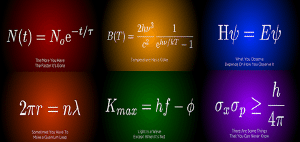Post
The Way the
Universe Changed
7 July 2013
 Brian Koberlein
Brian KoberleinAt the end of the 1800s we finally knew how the universe worked. Newton’s laws of motion and gravity had been studied for 200 years, and had become the pinnacle of scientific precision. James Clerk Maxwell had unified the electricity, magnetism and light into a single elegant theory, and Darwin’s theory of evolution explained how living things were connected. There were still mysteries to be explored, but it seemed the grand structure of the universe was now known. We lived in a clockwork universe, where cause led to effect, where simple laws governed complex mechanisms. It was a proven world, as I’ve written about in an earlier series of posts.
At the time it was generally thought that the nagging mysteries such as the structure of atoms and the structure of the universe would eventually come into the Newtonian fold. But they didn’t. Instead, small mysteries became large ones. The physical laws we thought we understood didn’t always apply. Understanding atoms and light would require a radically new way of looking at the universe. Some of the most cherished scientific ideas of precision and determinism would have to be discarded or revised. Science would undergo a quantum revolution.
Between 1900 and 1950 our understanding of the universe underwent a fundamental shift from a classical, clockwork universe to a quantum universe of probabilities and interactions. It was a shift that revealed a universe that was larger, younger and more profoundly complex than we had imagined.
This shift can be summarized in six simple equations shown below. Each one was a step toward modern quantum theory.
So this week we’ll look at each of these equations, how we came to understand them, and how they changed our view of the universe forever. We’ll start with the first one tomorrow. It describes radioactive decay, and it was the first clue that certain effects don’t have a mechanical cause.
The quantum revolution starts tomorrow.